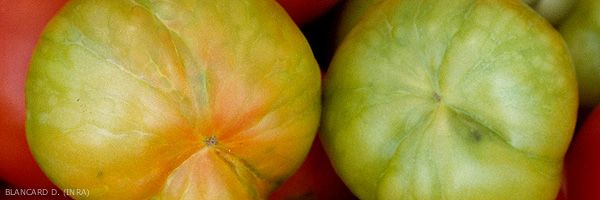
Genetic abnormalities in fruits
A large number of mutations are known in the tomato, modifying the expression of some of its genes. Their consequences can be clearly visible on plants or go unnoticed, essentially altering physiological processes. They correspond to rare events that geneticists sometimes take advantage of to create new varieties. Unfortunately, they can also be the cause of defects detrimental to tomato production, symptoms appearing on several organs, in particular on the fruits. In all cases, we will have to deal with so-called "genetic" conditions. Among these diseases, at least two are the cause of sectoral discolorations which can sometimes lead to confusion .
Argenture ( silvering )
This non-parasitic disease, in addition to the symptoms it causes on leaflets and stems, is the cause of sectoral defects in fruit coloring. The latter, sometimes deformed, present in particular green streaks, sometimes silvery, becoming pale yellow at maturity, this in case of partial manifestation. Sometimes larger, well-defined areas of the pericarp are affected. The ripening is incomplete, and the fruits are dotted with green islets with irregular outlines and arranged over the entire surface of the fruits (Figures 1 and 2).
Argenture ( silvering )
This non-parasitic disease, in addition to the symptoms it causes on leaflets and stems, is the cause of sectoral defects in fruit coloring. The latter, sometimes deformed, present in particular green streaks, sometimes silvery, becoming pale yellow at maturity, this in case of partial manifestation. Sometimes larger, well-defined areas of the pericarp are affected. The ripening is incomplete, and the fruits are dotted with green islets with irregular outlines and arranged over the entire surface of the fruits (Figures 1 and 2).
Leaf symptoms are due to an abnormality in the development of the palisade tissues of the lamina, occurring at a very early stage in their development. The origin of those observed on fruits are, to our knowledge, unknown. They are probably interdependent with the synthesis of chlorophyll. We advise you to consult the topic Silvering in order to have more information on this non-parasitic disease and on the factors which condition its expression. Varieties are sometimes indicated as resistant to silver plating, with the symbols " wi " or " si ", according to the catalogs of the seed companies.
Zébrure ( zebra stripe )
This non-parasitic curiosity is characterized by the presence, on green fruits, of a series of spots of limited size and dark green in color distributed in a particular way: in line, from the peduncular scar to the stylar scar (figure 3). . When they are very numerous and they merge, these spots form almost discontinuous bands between the two poles of the fruits, literally streaking the latter. Most of the time, these changes disappear during the ripening of the fruits. Note that this symptom gives the affected tomatoes the appearance of fruits produced by the variety 'Green zebra'. This affection, certainly of genetic origin, appears in certain environmental conditions which are still poorly understood. It would be genetically related to tomato fruit pox and to the golden speckle.
This non-parasitic curiosity is characterized by the presence, on green fruits, of a series of spots of limited size and dark green in color distributed in a particular way: in line, from the peduncular scar to the stylar scar (figure 3). . When they are very numerous and they merge, these spots form almost discontinuous bands between the two poles of the fruits, literally streaking the latter. Most of the time, these changes disappear during the ripening of the fruits. Note that this symptom gives the affected tomatoes the appearance of fruits produced by the variety 'Green zebra'. This affection, certainly of genetic origin, appears in certain environmental conditions which are still poorly understood. It would be genetically related to tomato fruit pox and to the golden speckle.





